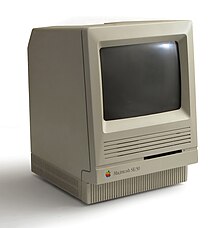
Back Macintosh SE/30 German Macintosh SE/30 Finnish Macintosh SE/30 French Macintosh SE/30 Hungarian Macintosh SE/30 Italian Macintosh SE/30 Japanese Macintosh SE/30 Dutch Apple Macintosh SE 30 Serbian Macintosh SE#SE/30 Swedish
 | |
| Manufacturer | Apple Computer |
|---|---|
| Product family | Compact Macintosh |
| Type | All-in-one |
| Release date | January 19, 1989 |
| Introductory price | US$4,369 (equivalent to $10,740 in 2023) |
| Discontinued | October 21, 1991 |
| Operating system | System 6.0.3 – System 7.5.5 With a 32-bit clean ROM upgrade, Mac OS 7.6 - Mac OS 8.1, A/UX |
| CPU | Motorola 68030 @ 15.667 MHz Motorola 68882 FPU |
| Memory | 1 MB RAM, expandable to 128 MB (120 ns 30-pin SIMM) |
| Display | 9 in (23 cm) monochrome, 512 × 342 |
| Dimensions | Height: 13.6 in (35 cm) Width: 9.6 in (24 cm) Depth: 10.9 in (28 cm) |
| Mass | 19.5 lb (8.8 kg) |
| Predecessor | Macintosh SE |
| Successor | Macintosh Classic Macintosh Classic II |
| Related | Macintosh IIx Macintosh IIfx Macintosh II Macintosh IIcx Macintosh IIci Macintosh Portable |
The Macintosh SE/30 is a personal computer designed, manufactured and sold by Apple Computer from January 1989 to October 1991. It is the fastest of the original black-and-white compact Macintosh series.
The SE/30 has a black-and-white monitor and a single Processor Direct Slot (rather than the NuBus slots of the IIx, with which the SE/30 shares a common architecture) which supported third-party accelerators, network cards, or a display adapter. The SE/30 could expand up to 128 MB of RAM (a significant amount of RAM at the time), and included a 40 or 80 MB hard drive. It was also the first compact Mac to include a 1.44 MB high density floppy disk drive as standard (late versions of the SE had one, but earlier versions did not). The power of the SE/30 was demonstrated by its use to produce the This Week newspaper, the first colour tabloid newspaper in the UK to use new, digital pre-press technology on a personal, desktop computer.
In keeping with Apple's practice, from the Apple II+ until the Power Macintosh G3 was announced, a logic board upgrade was available for US$1,699 to convert a regular SE to an SE/30. The SE would then have exactly the same specs as an SE/30, with the difference only in the floppy drive if the SE had an 800 KB drive. The set included a new front bezel to replace the original SE bezel with that of an SE/30.
Although this machine was succeeded in Q4 of 1990 by the Macintosh Classic, the SE/30 wasn't discontinued until 1991 by the Macintosh Classic II, which despite featuring the same processor and clock speed, was only 60% as fast as the SE/30 due to its 16-bit data path,[1] supported no more than 10 MB of memory, lacked an internal expansion slot, and made the Motorola 68882 FPU an optional upgrade.
- ^ "Mac Classic II, a Compromised Mac". Low End Mac. March 12, 2014. Archived from the original on August 27, 2019. Retrieved August 27, 2019.